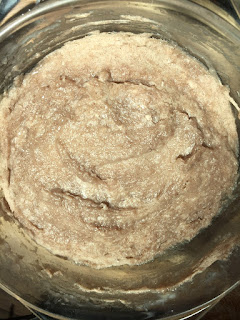The hardest part about making these muffins is consistency, because their success is based completely on the ripeness of your plantains, which can be very variable. If it's hot, the plantains that were perfect at 8am might be too ripe by 4pm when you finally get the time to bake them! Don't be afraid to try them through, because with practice, they become a fantastic addition to your AIP arsenal. (Note: this recipe has flaxseed in it, which is technically a reintroduction. You could try it subbing gelatin eggs for the flax if you aren't ready to try the seed.)
So, the plantains.
The plantains here in the front are just about what you're looking for, especially for savory muffins...maybe one more day for sweet. The yellow/brown ones in the back are too ripe.
If you use plantains that are too ripe, they will take FOREVER to bake, and will remain very wet inside, even after baking for over an hour. If this happens, don't throw them out! Freeze them, and then re-heat in the oven (toaster oven, whatever) until the outsides are crispy. They're quite delicious this way, but wouldn't be something we would necessarily serve to guests, know what I mean?? :D
Sweet Plantain Muffins
4 ripe-but-not-yet-browning plantains
3/4 cup golden flaxseed meal (regular is okay, but golden is better)
1.5 cups warm water
1 tsp apple cider vinegar
1 Tbsp vanilla
1.5 tsp baking soda
1/2 tsp salt
3/4 cup arrowroot
6 Tbsp coconut sugar
1/3 cup palm shortening, melted
Peel, chop, and then blend plantains in a food processor until smooth.
Mix flax, water, vinegar, and vanilla in a bowl and let sit about ten minutes, whipping with a fork randomly. The more you whip it, the more gelatinous it will become. It should look like egg-consistency when it's ready.
Add baking soda, salt, tapioca, and sugar to the plantains (we do all of this in the food processor) and mix.
Add melted shortening, pulse, add wet flax mixture. Blend for about 2 minutes.
We bake these in silicone muffins pans; originally we used cupcake papers in regular tins, but much of the muffin ended up sticking to the paper (even with oil), and this way we get 100% of the muffins to eat.
Once we scoop all the batter, we add blueberries and/or raspberries and/or Enjoy Life chocolate chips (reintroduction!) to each individual cup. It just works better this way.
Oven should be about 375 degrees, and they take quite a while. We check at 35 minutes, and then every ten minutes, but they will likely bake for an hour or up to 90 minutes. I know that's a huge variable, but it all depends on the particular plantains you have that day. If, after, 75-90 minutes they still seem soft, take them out and let them cool completely, then freeze. They are actually really delicious once reheated to make the outside crispy.
Savory Plantain Muffins (optional Olive-Rosemary Muffins)
Same as above, EXCEPT:
- Plantains should be a day or two less ripe (greener) than described above
- OMIT the sugar and vanilla
If you want to get fancy, when you melt your shortening, add some rosemary to the oil and let it steep for about 15 minutes, and then remove the herb. Then you will have rosemary-flavored plantain muffins, and you can even add good olives to the muffins before baking and then you have fancy olive-rosemary plantain bread!




























